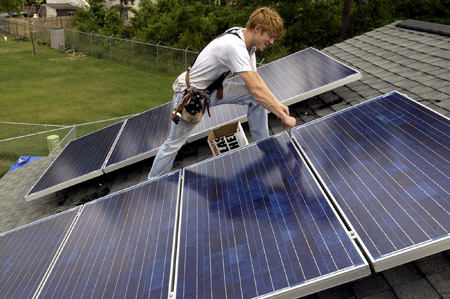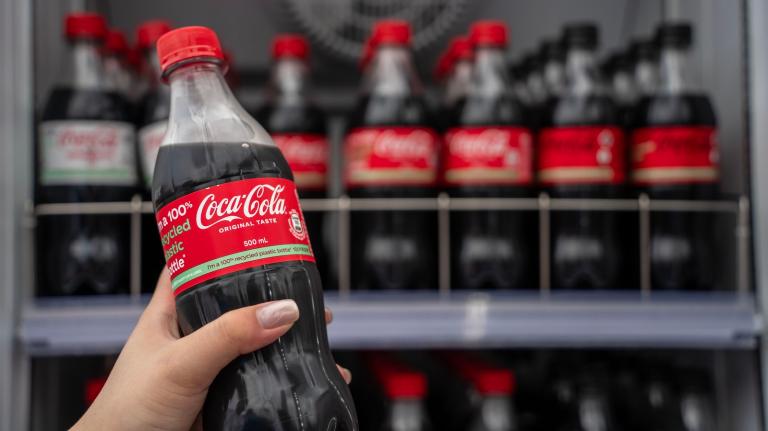
Robert Pollin has issued a direct rebuttal, “Green Investments and Jobs,” to the Heritage Foundation’s lame “debunking” of Green Recovery, a study Pollin co-authored for the the Center for American Progress. My line-by-line response to the disanalysis by Heritage’s Donald Kreutzer is here.
Pollin, co-director of the Political Economy Research Institute at U. Mass-Amherst, concludes:
Public investments in energy efficiency and renewable energy can overturn the long-held conventional wisdom reflected in Kreutzer’s critique, which claims we can have a green economy or a growing economy, but not both. In fact, green public investments to fight global warming are both a powerful engine of job creation and a necessary instrument for achieving environmental sustainability.
Pollin has included a summary of his basic arguments that is well worth reading:
First, green investments-including energy efficiency measures such as building retrofits, public transportation, freight rail, and “smart grid” electrical transmission systems; and renewable sources such as wind, solar, and biomass energy-are all potent sources of net job creation relative to spending on traditional fossil fuels, including oil, coal, and natural gas. By “net job creation,” I mean that green investments will create more jobs for a given amount of spending than expenditures within the oil, natural gas, or coal industries. For instance, spending $1 million on green investments will create about 17 jobs within the U.S. economy, while spending the same $1 million within the oil industry will create about 4.5 jobs.
Second, the main reasons green investments are a source of net job creation relative to spending within the traditional fossil fuel industries actually has nothing to do with whether the investments are “green.” Rather, there are two primary factors at play. The first factor is higher “labor intensity” of spending-that is, more money is being spent on hiring people and less on machines, supplies, and consuming energy. This becomes obvious if we imagine hiring construction workers to retrofit buildings or install solar panels, or bus drivers to expand public transportation offerings, as opposed to drilling for oil off the coasts of Florida, California, and Alaska. The second factor is the “domestic content” of spending-how much money is staying within the U.S. economy as opposed to buying imports or spending abroad. When we retrofit public buildings and private homes to raise their energy efficiency, or improve our public transportation systems, virtually every dollar is spent within the U.S. economy. By contrast, only 80 cents of every dollar spent within the oil industry remains within the United States.
Third, “Green Recovery”advances a short-term economic stimulus proposal as a tool for fighting the severe current recession. The first purpose of any short-run stimulus program-regardless of whether it is centered around green investments, household consumption, or expanding unemployment insurance benefits-is to inject more spending into the economy as quickly as possible. We pay for such short-run measures primarily through allowing the federal deficit to rise. As such, in “Green Recovery,” we do not propose any tax increases whatsoever in the short term. A $1 million increase in spending on green investments will therefore produce 17 new jobs, with no offsets in spending cuts or job losses elsewhere in the economy.
Fourth, over the longer term-once the current recession is behind us-any further increases in green investments financed by the government will indeed need to be matched by corresponding increases in tax revenues or cutbacks in government subsidies. Let’s consider a simple case in which $1 million in public green investments is financed by cutting subsidies for oil companies by $1 million, and that green investments thus rise by the same amount that spending in the oil industry falls. This will still produce a large net increase in jobs, since the $1 million in new green investment spending will produce 17 jobs, while the $1 million cut in oil industry spending will produce a loss of 4.5 jobs. The net gain in jobs-adding up the expansion of green investments along with the reduction in oil industry spending-is therefore 12.5 jobs.
Fifth, the green investment program does not result in higher energy costs with any investments that are capable of improving energy efficiency. As we report in “Green Recovery,” for a $2,500 up-front investment in home retrofitting, the average U.S. household is likely to save about $900 per year in its overall energy bills. That means that the household would fully recover its up-front retrofit investment in three years ($900 in energy savings every year produces $2,700 in savings for three years). Thereafter, the household would be paying $900 per year less for energy than it would if it hadn’t invested in the retrofit. Meanwhile, the project of retrofitting the homes will produce jobs for electricians, carpenters, roofers, truck drivers, accountants, and secretaries, among other occupations.
Finally, most forms of renewable energy-wind, solar, geothermal, and biomass fuels-are more expensive to purchase now than conventional oil, coal, or natural gas. But this is primarily because we take no account of the costs of emitting carbon into the environment through burning fossil fuels-that is, we continue to ignore the realities of global warming in setting prices for fossil fuels. Because global warming does indeed represent a great peril to our environment and our economy, it is imperative that we invest now to lower the costs of clean energy alternatives. Tremendous advances have already been made in this area-to the point where some types of renewable energy are approaching cost competitiveness with fossil fuels. Advancing these new renewable forms of energy is also a powerful source of job creation for people working in a wide range of occupations, including sheet metal workers, agricultural workers, and chemical technicians, as well as research scientists and patent lawyers.
See here for a discussion of how investments in clean technology deployment are helping to bring down their price to levels competitive with fossil fuels (even without a price for carbon that reflects its damage to the climate).
This post was created for ClimateProgress.org, a project of the Center for American Progress Action Fund.

